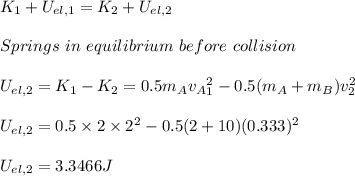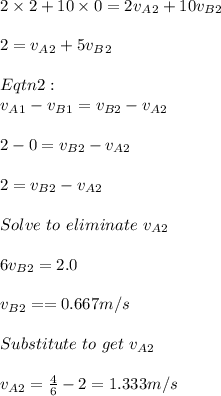
Blocks A (mass 2.00 kg) and B (mass 6.00 kg) move on a frictionless, horizontal surface. Initially, block B is at rest and block A is moving toward it at 2.00 m/s. The blocks are equipped with ideal spring bumpers. The collision is head-on, so all motion before and after the collision is along a straight line. (a) Find the maximum energy stored in the spring bumpers and the velocity of each block at that time. (b) Find the velocity of each block after they have moved apart.

Answers: 1


Another question on Physics

Physics, 21.06.2019 21:20
An artificial satellite circles the earth in a circular orbit at a location where the acceleration due to gravity is 6.03 m/s^2. determine the orbital period of the satellite.
Answers: 3

Physics, 21.06.2019 22:30
Under conditions for which the same room temperature is maintained by a heating or cooling system, it is not uncommon for a person to feel chilled in the winter but comfortable in the summer. provide a plausible explanation for this situation (with supporting calculations) by considering a room whose air temperature is maintained at 20â°c throughout the year, while the walls of the room are nominally at 27â°c and 14â°c in the summer and winter, respectively. the exposed surface of a person in the room may be assumed to be at a temperature of 32â°c throughout the year and to have an emissivity of 0.90. the coefficient associated with heat transfer by natural convection between the person and the room air is approximately 2 w/m2 â‹…â‹… k. what is the ratio of the thermal resistance due to convection to the thermal resistance due to radiation in the summer? what is the ratio of thermal resistances in the winter
Answers: 1

Physics, 22.06.2019 05:00
Which car has the most kinetic energy? a. a car of mass 1000 kg with a speed of 3 m/s b. a car of mass 2000 kg with speed 7 m/s c. a car of mass 1000 kg with speed 7 m/s d. a car of mass 2000 kg with speed 3 m/s
Answers: 1

Physics, 22.06.2019 09:40
(a) assume the equation x = at^3 + bt describes the motion of a particular object, with x having the dimension of length and t having the dimension of time. determine the dimensions of the constants a and b. (use the following as necessary: l and t, where l is the unit of length and t is the unit of time.) (b) determine the dimensions of the derivative dx/dt = 3at^2 + b. (use the following as necessary: l and t, where l is the unit of length and t is the unit of time.)
Answers: 1
You know the right answer?
Blocks A (mass 2.00 kg) and B (mass 6.00 kg) move on a frictionless, horizontal surface. Initially,...
Questions


Chemistry, 24.09.2019 15:00

History, 24.09.2019 15:00

Biology, 24.09.2019 15:00

Mathematics, 24.09.2019 15:00

Social Studies, 24.09.2019 15:00


Biology, 24.09.2019 15:00

Chemistry, 24.09.2019 15:00


Social Studies, 24.09.2019 15:00

Social Studies, 24.09.2019 15:00

Social Studies, 24.09.2019 15:00

Social Studies, 24.09.2019 15:00



History, 24.09.2019 15:00

Biology, 24.09.2019 15:00


Biology, 24.09.2019 15:00


 be the mass of block A, and
be the mass of block A, and be the mass of block B. The initial velocity of A,
be the mass of block B. The initial velocity of A,









